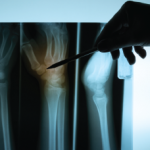There has also been progress in understanding how to administer pulse cyclophosphamide (CTX), another conventional therapy for SLE, Dr. Wofsy said. The recent Euro-Lupus Nephritis Trial (ELNT), conducted in Europe, concluded that low-dose treatment with pulse CTX was just as effective as high-dose treatment, and with fewer infections.11 To date, there has been reluctance in the U.S. to generalize from its results, he noted, largely due to concerns that low-dose CTX might not be as effective in racial and ethnic minorities in the U.S. To address this concern, UCSF has been studying the effects of the ELNT regimen in diverse populations.
The recent approval of belimumab, a monoclonal antibody that inhibits B-cell function, has generated great excitement in the lupus community, Dr. Wofsy said. Two trials have demonstrated its benefits in lupus patients with diverse manifestations of the disease, but further studies are currently in progress to determine which manifestations of lupus, and which patient subpopulations, might benefit most from this therapy. Numerous other biologic therapies are currently under investigation, he said.
Larry Beresford is a freelance journalist based in California.
References
- For information, see: www.calduals.org. Accessed June 12, 2012.
- Aletaha D, Martinez-Avila J, Kvien TK, Smolen JS. Definition of treatment response in rheumatoid arthritis based on the simplified and the clinical disease activity index. Ann Rheum Dis. 2012 Mar 27. [Epub ahead of print].
- Pincus T, Swearingen CJ, Bergman M, Yazici Y. RAPID3 (Routine Assessment of Patient Index Data 3), a rheumatoid arthritis index without formal joint counts for routine care: Proposed severity categories compared to disease activity score and clinical disease activity index categories. J Rheumatol. 2008;35:2136-2147.
- Black DM, Bauer DC, Schwartz AV, Cummings SR, Rosen CJ. Continuing bisphosphonate treatment for osteoporosis—for whom and for how long? NEJM. 2012;366:2051-2053.
- Whitaker M, Guo J, Kehoe T, Benson G. Bisphosphonates for osteoporosis—where do we go from here? NEJM. 2012;366:2046-2051.
- Boonen S, Ferrari S, Miller PD, et al. Postmenopausal osteoporosis treatment with antiresorptives: Effects of discontinuation or long-term continuation on bone turnover and fracture risk—a perspective. J Bone Miner Res. 2012;27:1-12.
- Khosla S, Bilezikian JP, Dempster DW, et al. Benefits and risks of bisphosphonate therapy for osteoporosis. J Clin Endocrin Metab. 2012 Apr 20. [Epub ahead of print].
- Romo C, Salahi L. Osteoporosis drugs, like Fosamax may increase risk of broken bones in some women. Published March 8, 2010. Available at http://abcnews.go.com/WN/WorldNews/osteoporosis-drugs-fosamax-increase-risk-broken-bones-women/story?id=10044066. Accessed June 12, 2012.
- Lewiecki E, Laster A, Miller P, Bilezikian J. More bone density testing is needed, not less. J Bone Miner Res. (in press).
- Miller PD. A review of the efficacy and safety of denosumab in postmenopausal women with osteoporosis. Ther Adv Musculoskelet Dis. 2011;20:1-12.
- Houssiau FA, Vasconcelos C, D’Cruz D, et al. The 10-year follow-up data of the Euro-Lupus Nephritis Trial comparing low-dose and high-dose intravenous cyclophosphamide. Ann Rheum Dis. 2010;69:61-64.

